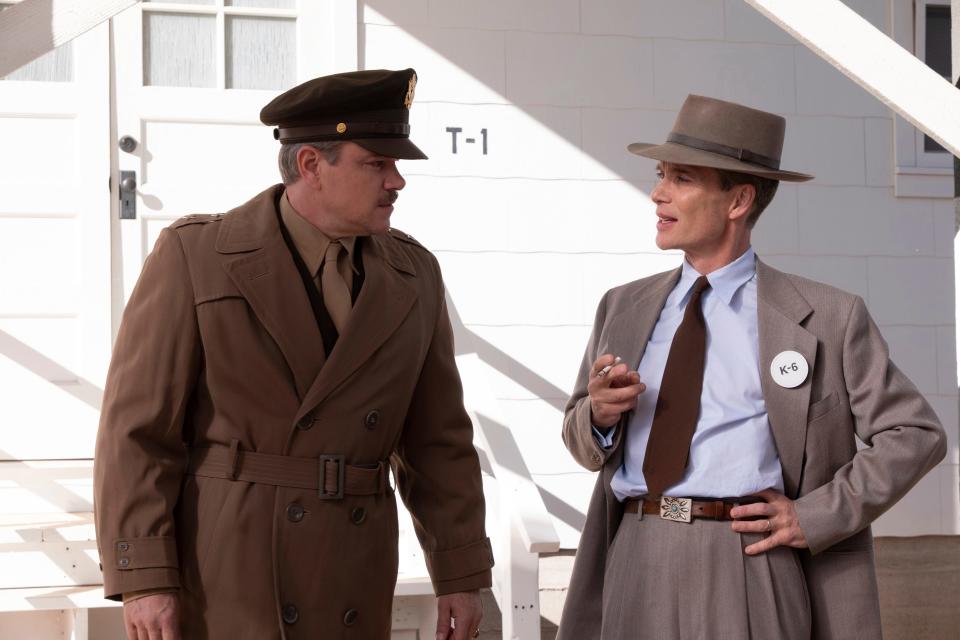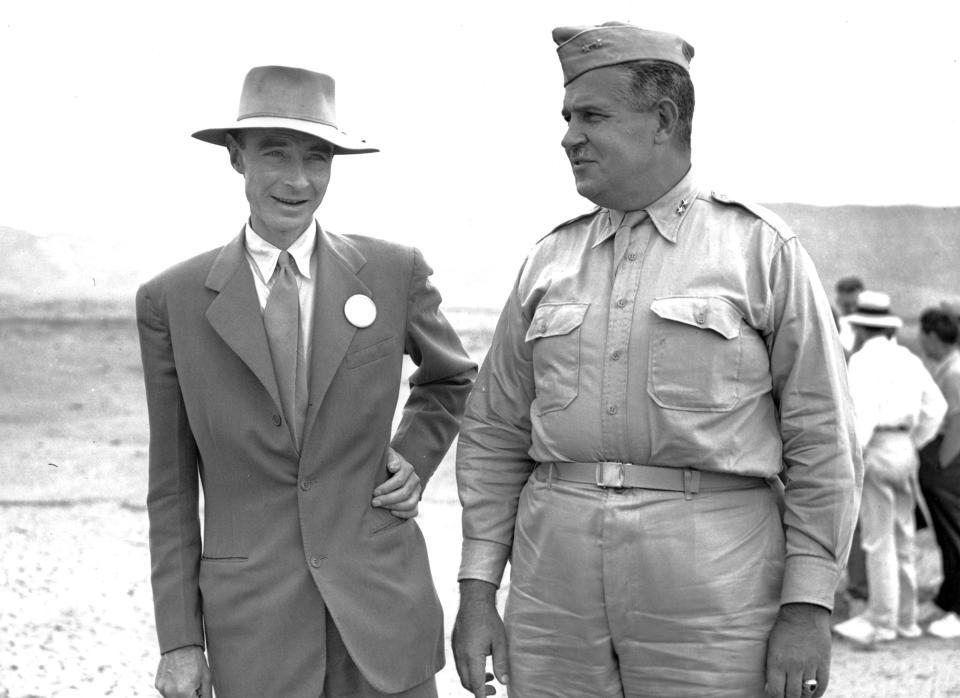A Delaware company had a big role in the Manhattan Project. Is it a part of 'Oppenheimer'?
- Oops!Something went wrong.Please try again later.
- Oops!Something went wrong.Please try again later.
"Oppenheimer, a movie written and directed by Christopher Nolan, is the story of American theoretical physicist J. Robert Oppenheimer and his part in the development of the atomic bomb that abruptly ended World War II.
The thriller comes out Friday, and it remains to be seen what, if any, role the Wilmington-based DuPont Co. and its employees play in the film that ties together physics, engineering and chemistry.

DuPont was a significant part of the "Manhattan Project" the code name given to the top-secret project that produced the atomic bomb.
"The $2 billion project employed over 125,000 people across America, most of whom had no idea what they were working on," according to an exhibit at the National World War II Museum in New Orleans.
But the Delaware company, which produced enough enriched Uranium-235 to make the bomb that destroyed Hiroshima and enough plutonium for the Nagaski bomb, was not involved in the decision to drop bombs on the Japanese cities.
DuPont's Atomic Energy Division documents and records on atomic weapons and nuclear energy stored at Hagley Museum and Library in Greenville offer greater insight into the top-secret nature of the project conducted during World War II and the company's involvement.
The museum has had exhibitions over the years about DuPont and the Manhattan Project.
Three years ago, when the museum was closed to visitors due to the pandemic, historian Lucas Clawson on YouTube discussed DuPont's role in the Manhattan Project and the development of the first operational nuclear reactors.
During the hourlong video, which showcases rare documents, footage and photographs from Hagley’s collection, Clawson describes the top-secret project to develop a weapon and how it served as a major catalyst in the Cold War between the Soviet Union and the United States.
Lt. Gen. Leslie Groves (played in the movie by Matt Damon) was a United States Army Corps of Engineers officer in charge of the construction of the Pentagon.
He became the military head of the Manhattan Project by then-President Franklin Roosevelt after German-born physicist Albert Einstein wrote to the president in 1939 telling him to research atomic weapons because if dictator Adolf Hilter developed one first, the Nazis might win the war and wipe out civilization.
(Ironically, Einstein was denied security clearance by the Army to work on the project and no other scientists or engineers could consult with him. Due to his politically left leanings, Einstein was considered a security risk, according to the American Museum of Natural History.)
With the green light lit, the race for atomic power was on. While recruiting scientists and companies for the Manhattan Project, Groves sought out trustworthy people, according to Clawson. The military leader was well-acquainted with the DuPont Co., a known explosives company that was transitioning into a respected chemical engineering company that had in recent years invented nylon.

In November 1942, Groves came to Wilmington and met with DuPont Co. President Walter Samuel Carpenter Jr. and briefed him on the Manhattan Project. He wanted the company to build and operate plutonium production reactors and other facilities, according to the U.S. Department of Energy.
The company's executive committee and board, which included Carpenter, the first member who was not from the du Pont family, were reluctant and had several concerns about their involvement.
According to Clawson, one of the biggest factors was they were not convinced about its safety, a tenet of DuPont since the company was founded as a manufacturer of gunpowder on the banks of the Brandywine in 1802.
Carpenter has said he realized the results of this incredibly dangerous new science of splitting the atom and plutonium could be catastrophic.
Still, Carpenter said he felt DuPont, an American company, had to be involved as a patriotic contribution.
On Dec. 21, 1942, DuPont agreed to take on the Manhattan Project, according to Hagley, but with some conditions. The cost would be $1 because the company didn't want to look like it was profiting from the war.
DuPont was still smarting after it had been criticized as "a merchant of death" after producing 40% of smokeless gunpowder used by the Allies during World War I. DuPont said any profits would be returned to the government.
DuPont also wanted to ensure it would have no liability if something went wrong and wanted out of the project by the end of the war.

"One of the amazing aspects of the thing was that nobody in Wilmington here seemed to know what was going on out there," Carpenter said in a 1965 interview for the “Voices of the Manhattan Project,” a joint project by theAtomic Heritage Foundation and the Los Alamos Historical Society,
"It had to be kept very secret, and of course, it was kept very secret," Carpenter said.
Walter Carpenter State Park, a part of the White Clay Creek Preserve near Newark, is named after the DuPont Co. president and chairman who died in 1976.
DuPont chemical engineer Crawford Greenewalt soon was sent by Carpenter to investigate the project. In Chicago on Dec. 2, 1942, he witnessed Italian physicist Enrico Fermi’s first chain reaction. His engineering notebooks, with the words "secret' stamped in red on the pages, are a part of Hagley Museum and Library's archives.
Greenewalt, married to Margaretta Lammot du Pont, the daughter of DuPont Co. President Irénée du Pont. served as the DuPont Co. president from 1948 to 1962. He retired as board chairman in 1967 and died at age 91 in 1993.
Greenewalt's brother-in-law was Irénée du Pont Jr., who owned Granogue, the stunning 505-acre private estate near Centreville, Delaware. The estate was acquired by Longwood Gardens in February about a month after du Pont's death at age 103.
During World War II, Greenewalt became the liaison between the physicists at the Chicago Met Lab and DuPont's engineers at Wilmington, according to Atomic Heritage Foundation. His role was helping translate scientists’ theoretical ideas into workable blueprints for the production of plutonium on a massive scale at a reactor that was built in Hanford, Washington.
With the Army's help, DuPont Co. set up a temporary central construction camp accommodating up to 51,000 people and built permanent housing for a community, with schools, churches, and grocery stores, of up to 17,500 people also in Washington.

Greenewalt chose DuPont's chief engineer Grenville M. "Slim" Read to head up the design of the facilities that also included a reactor at Oak Ridge, Tennessee. At its Deepwater, New Jersey, plant, DuPont operated one of the three parallel production lines set up for processing uranium ore into metal.
When the first test atomic fission bomb exploded at a remote air base in Alamogordo, New Mexico, on July 16, 1945, Groves called Read in Delaware, according to News Journal archives.
Afraid that his call might be bugged by spies, Groves said just two words: "It worked."
"You lucky SOB. You hit the jackpot on DuPont's nickel," Read said.
Contact Patricia Talorico at ptalorico@delawareonline.com and follow her on Twitter @pattytalorico.
How the rich lived. Delaware's Gilded Age: Here's a guide to 15 du Pont family estates
Losing its luster: Hospital dropping duPont name: Is this erasing Delaware history?
Famous Centreville area home EXCLUSIVE: This Delaware du Pont estate may be worth $50 million. Look who's buying it.
This article originally appeared on Delaware News Journal: Will this Delaware company have a role in new 'Oppenheimer' movie?

